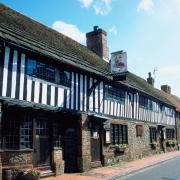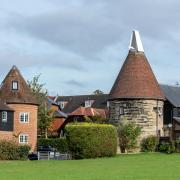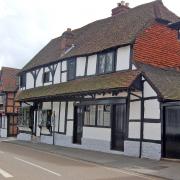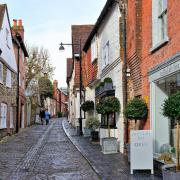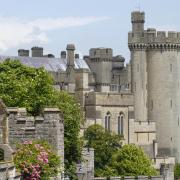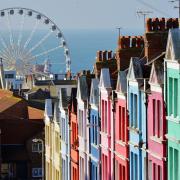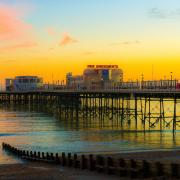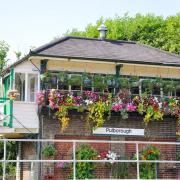Chichester Cathedral’s spire was a great Sussex landmark for 700 years. Then one day in 1861 it suddenly collapsed
On a February day in 1861 – 157 years ago – the vicar of South Bersted, near Bognor, was just about to start his lunch when a message came that Robert, his gardener, urgently wished to see him. The man, a sturdy Sussex labourer, was shown into the study.
“What’s wrong Robert?” asked the vicar, seeing he was extremely agitated about something.
“Head bad, sir. Fit coming on,” was the reply. “Perhaps you could give me a note for the doctor. Can’t see objects.”
“You found your way into this room right enough.”
“Yes,” Robert replied. “But I can’t fix things at a distance.”
“What things did you look at?”
“Well, ‘fore I had started work, I looked about and saw everything I should. Like the spire...”
“Of Chichester Cathedral?”
“Yes sir. Then I did some digging for a while, then looked up again and the spire were gone.”
“Gone?”
“It’s the truth sir. I couldn’t see it where it should be. And I shut my eyes and opened them again quick and I rubbed them and no ways could I catch the spire; and I knew then I was took bad.”
When the vicar went to check for himself he couldn’t see the spire either – but there was nothing wrong with either’s eyesight. What had happened was that while Robert was bent digging, the great spire of Chichester Cathedral had collapsed.
At about 1.30pm on Thursday 21 February, 1861, the spire leaned slightly to the south-west, then telescoped neatly and apparently, almost soundlessly, down into the tower below it, producing a huge cloud of dust and severely damaging a large part of the cathedral transept.
But it wasn’t entirely unexpected. When a large screen was removed in 1860 (the wooden partition separating the chancel from the main body of the church) it was discovered that the piers supporting the tower above – which in turn supported the spire – were in an extremely weak condition. Efforts were made to shore them up and create new stone work in the weakest places, but fresh cracks appeared and the walls began to bulge. Some 70 men worked night and day to save the building, but to no effect and the great collapse “as one telescope tube slides into another” took place, the whole fall “being an affair of a few seconds”. We’re told: “The workmen were fortunately at dinner, and no one was injured.”
Chichester Cathedral was founded in 1075, by order of William the Conqueror. The building looked very different then from how it looks today. Consecrated in 1108 under Bishop Ralph de Luffa, fires of 1114 and 1186 saw substantial rebuilding and much damage was later done during the Reformation in 1538. The spire, originally built in the 14th century had to be repaired in 1684 by Sir Christopher Wren who had the ingenious idea of suspending a giant wooden pendulum inside to counteract the force of the wind. It survived a vicious lightning strike in 1721.
Frank Patterson of Billingshurst had an interesting letter published in the old Sussex County Magazine (in May 1935) about the tower’s fall.
“In the year 1861 [my grandfather] was on duty up on the old semaphore in Portsmouth Dockyard, sweeping the horizon with a telescope. By strange coincidence he happened to be looking at the Cathedral when it suddenly disappeared. His tale was not believed till other telescopes were brought into play. I well remember the old gentleman telling me the tale in my childhood of how it appeared not to fall over, but rather collapse like a concertina.”
Restoration of the spire, tower and damaged transept wasn’t a straightforward job. Following an appeal, which raised more than £53,000, eminent architect Sir George Gilbert Scott was given the job of overseeing the task, but no original plans existed. It was fortunate that Joseph Butler, once surveyor to the church authorities, had made some detailed, measured drawings of the tower and spire himself, which enabled Scott to produce the careful copy of the original that we see today. Pity his poor assistants on the project, whose first task was to sift through all the tons of rubble, sorting out which stones and carvings could be saved and used!
The foundation of the new tower was laid on 2 May 1865 and ‘capped’ in June 1866. The church was reopened for divine service the following year. The old screen was restored nearly 100 years later in 1961. One bizarre twist to the story was how on the day of the disaster, one local paper was dismissing “absurd reports circulating as to the danger of the spire falling”.
It’s easy to image someone in the street, reading their paper, then looking across at the spire, relieved all would be well, then – wham! – down it went!
And even more strangely, there was an old local proverb about Chichester, which said: “If Chichester church steeple fall, In England there’s no king at all.”
And it had been proved right – the spire had fallen during the reign of Queen Victoria.
More…
• What it’s like to live in Chichester - West Sussex’s only city is still booming with its combination of history and cutting edge culture. Duncan Hall finds out more








